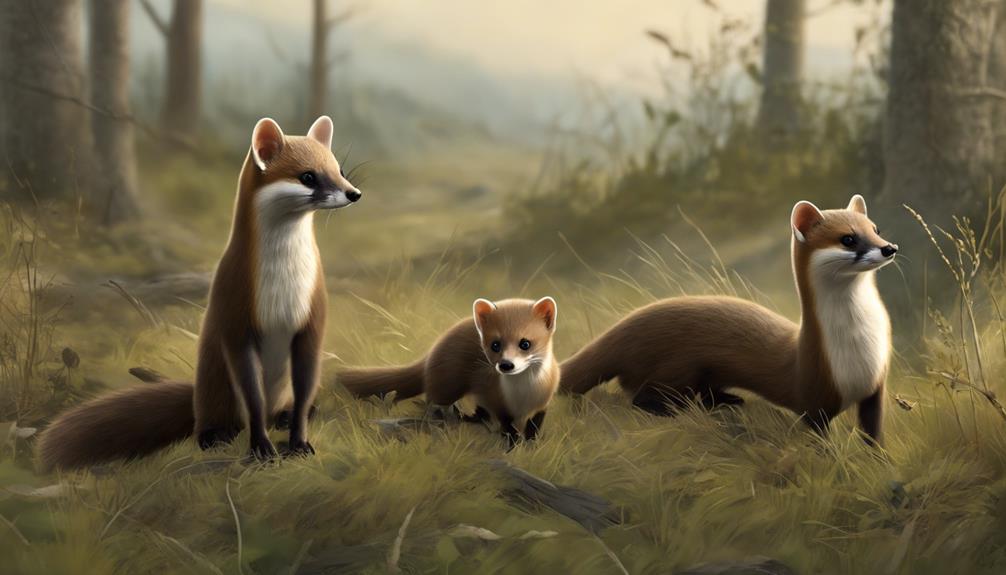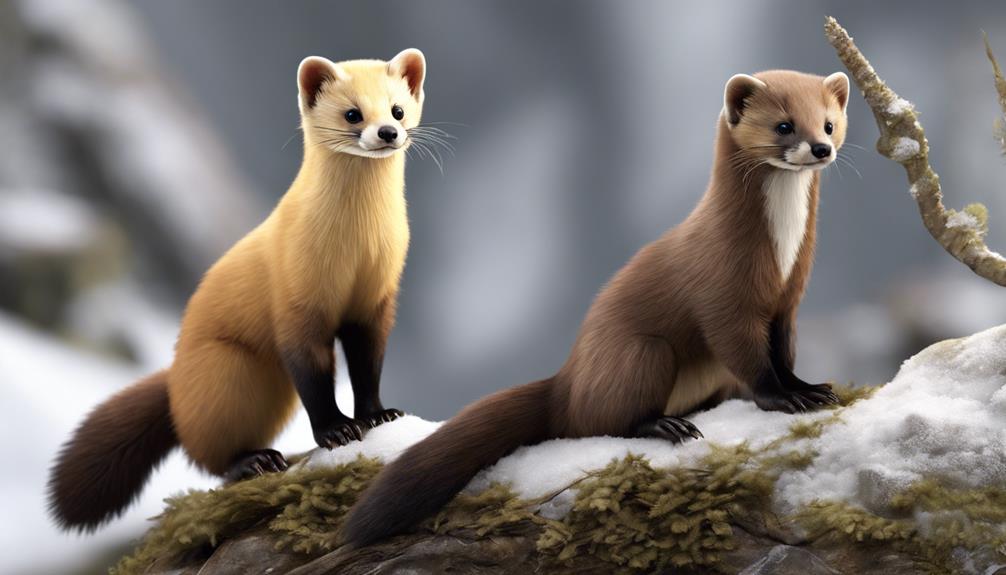When figuring out the differences between martens and weasels, look at their bodies; martens are bigger with darker, bushy fur, while weasels are slinkier with shorter tails. Watch for tail length and color; martens have bushy black tails for balance, but weasels have short, brown tails for utility. Check their hunting habits too; weasels are speedy bird and rat hunters, while martens are patient and prey on eggs and insects. Pay attention to where they live; martens prefer forests, weasels thrive in various habitats. Understanding these key points helps identify these creatures, revealing more distinctive features about them.
Key Takeaways
- Martens have robust bodies, bushier dark tails, and solitary habits.
- Weasels possess shorter brown tails, sleek bodies, and active social behavior.
- Martens hunt with stealth for arboreal prey, while weasels rely on speed for ground-dwelling hunting.
- Martens prefer dense evergreen forests, weasels thrive in various environments.
- Martens communicate through scent marking, weasels use vocalizations and social behaviors.
Physical Appearance
I can differentiate between martens and weasels by observing their distinct physical appearances. Martens have a more robust body length compared to weasels, with weasels typically ranging from 20-27cm. The fur of martens is usually darker and bushier, while weasels sport shorter, stubby brown tails.
When it comes to behavior, martens are known for their shy and solitary nature, preferring mature evergreen forests as their habitat. On the other hand, weasels can adapt to various environments and are more active and bold in their actions. Additionally, weasels have a slinkier body shape, making them distinguishable from the more solidly built martens.
Tail Length and Color

In distinguishing between martens and weasels, a key feature to take into account is their tail length and color. Martens sport bushy, almost black tails that are quite distinctive. These tails aren't just for show; they play an essential role in the marten's arboreal lifestyle. When climbing trees, the tail aids in balance and agility, making it an important distinguishing feature of the marten.
On the other hand, weasels have short, stubby tails that are typically brown. Unlike the prominent tails of martens, weasels' tails are more utilitarian, suited for their ground-dwelling habits. The color and length of the tail are key physical features that can help you tell martens and weasels apart.
Hunting Techniques

When comparing martens and weasels, understanding their distinct hunting techniques sheds light on their predatory behaviors and ecological roles in their habitats. Weasels rely on their speed and agility to swiftly hunt down prey like birds, rats, and mice. Their quick movements and nimbleness make them efficient predators in capturing small animals. On the other hand, martens utilize stealth and patience to stalk and ambush their prey, which can include birds' eggs, insects, and small mammals. This method allows martens to carefully plan their attacks and secure their meals without expending unnecessary energy.
Weasels are notorious for their destructive behavior in chicken coops, where they hunt and kill poultry for food. In contrast, martens are skilled climbers and often pursue squirrels and other arboreal prey in the treetops. Additionally, weasels have high metabolisms and need to consume a large amount of food relative to their size to sustain their energetic hunting lifestyle. These contrasting hunting techniques showcase the diverse strategies employed by martens and weasels in their quest for survival.
Preferred Habitats

Martens typically seek out mature evergreen forests with plenty of hiding spots and prey.
Weasels, on the other hand, are versatile creatures that can thrive in various settings, from grasslands to urban areas.
Understanding these habitat preferences gives insight into the different lifestyles of these fascinating animals.
Weasel Habitat Description
Weasels thrive in habitats with abundant cover such as woodlands, grasslands, and brushy areas, often located near water sources like streams, ponds, or marshes. These agile hunters prey on rodents, rabbits, and small birds in these environments.
Weasels are adaptable creatures, able to live in various habitats including farmlands and suburban areas. They utilize burrows made by other animals or create their own underground dens for shelter.
Their keen hunting skills make them well-suited to areas rich in prey. By taking advantage of the cover provided by woodlands and grasslands, weasels can move stealthily to catch their next meal.
Marten Preferred Environment
Nestled amidst the dense foliage of mature evergreen forests, martens prefer habitats teeming with abundant cover and a diverse array of food sources. These elusive creatures thrive in areas with ample tree cover, such as old-growth forests and coniferous woodlands.
Martens are skilled at maneuvering through dense vegetation, utilizing their adept climbing abilities to move through their preferred environment. They're known to feed on a variety of food sources including birds' eggs, insects, small mammals, and fruits found within their habitat.
Martens establish territories within these habitats, often marking them with scent glands to delineate their space. Their solitary nature aligns with their preference for secluded areas within the rich tapestry of mature evergreen forests.
Social Behavior

Martens and weasels have distinct social behaviors.
Martens are solitary creatures, preferring to live and hunt alone.
In contrast, weasels are more social and may form small groups or colonies.
Habitat Preferences
While preferring mature evergreen forests for their habitat, martens seek dense cover and a variety of prey. On the other hand, weasels are more adaptable, being found in a range of environments such as grasslands, forests, and even urban areas. Martens are known for their solitary nature, avoiding contact with others except during the breeding season, while weasels exhibit some social behavior by overlapping home ranges and having occasional interactions with other weasels. Martens mark their territories with scent markings, whereas weasels rely heavily on their agility and speed for hunting and survival.
| Martens | Weasels | Habitat Preferences |
|---|---|---|
| Mature evergreen forests | Range of environments | Prefer dense cover |
| Solitary | Some social behavior | Mark territories with scent |
| Variety of prey | Agile hunters | Breeding season interactions |
Communication Methods
In contrast to their solitary nature in habitat preferences, weasels exhibit social behavior through vocalizations and living in groups for communication methods. Weasels use vocalizations like squeaks and chirps to communicate with one another, while martens rely more on scent marking and body language.
Weasels tend to live in groups, known as packs, where they engage in play behavior to strengthen social bonds. Unlike martens, weasels are more independent and may share territories with other group members. During mating season, martens show more complex social behaviors, whereas weasels maintain consistent social interactions throughout the year.
Understanding these communication methods sheds light on the social dynamics of these fascinating creatures.
Group Dynamics
Understanding the social behavior of these fascinating creatures reveals intriguing insights into their group dynamics.
Martens typically lead solitary lives, while weasels are more social animals that form groups with hierarchical structures. In weasel communities, dominant individuals establish territories and take the lead, unlike martens who prefer to live independently.
Weasels engage in cooperative hunting and share food within their social structure, exhibiting playful behaviors like chasing and play fighting. Martens, on the other hand, are less likely to interact socially or participate in cooperative activities.
Weasels communicate through vocalizations and body language with conspecifics, enhancing their social bonds, whereas martens rely more on their solitary instincts.
Reproduction and Offspring

Reproduction and offspring differ greatly between martens and weasels in regards to litter size and developmental stages at birth. Martens typically have litters of 1-5 kits in the spring, while weasels give birth to 4-6 young in the summer. When it comes to the developmental stages at birth, weasel kits are born blind and hairless, depending entirely on their mother for warmth and nourishment. In contrast, marten kits are born with a fine layer of fur and are more developed right from birth.
To further illustrate these differences, let's compare the reproduction and offspring characteristics of martens and weasels in the table below:
| Characteristic | Martens | Weasels |
|---|---|---|
| Litter Size | 1-5 kits | 4-6 young |
| Development at Birth | More developed with fur | Blind and hairless |
| Nursing Period | About 6-8 weeks before introducing solid food | Weaned at around 8 weeks |
| Sexual Maturity | 1-2 years | 3-4 months |
| Breeding Season | Once a year | Multiple litters in a single breeding season |
Diet Variations

Exploring the dietary differences between martens and weasels reveals distinct preferences and hunting behaviors. When it comes to their diets, these creatures showcase interesting variations:
- Martens: Known for their diverse palate, martens enjoy a varied diet that includes insects, rodents, birds' eggs, and even blueberries. Their ability to consume such a wide range of foods showcases their adaptability and resourcefulness in the wild.
- Weasels: In contrast, weasels primarily focus on hunting birds, rats, and mice, which can sometimes lead to them causing damage in places like chicken coops. While they play an important role in controlling rodent populations, their diet tends to be more specialized compared to martens.
Understanding these distinct dietary preferences sheds light on the unique ways these animals interact with their environments. By observing what they eat, we can gain insight into their behaviors and the roles they play in their ecosystems.
Movement Patterns

Martens and weasels have distinct movement patterns that reflect their hunting strategies and habitats. Martens typically move with careful precision, slowly navigating their surroundings to hunt effectively.
In contrast, weasels showcase swift and agile movements, bounding with speed to catch their prey in diverse habitats.
Speed of Travel
When comparing martens and weasels, one can easily differentiate them by observing their distinct speed of travel and movement patterns. Martens tend to move at a slower, more deliberate pace, while weasels are known for their quick, agile movements, darting rapidly across the ground.
To visually imagine this difference:
- Martens cautiously and stealthily navigate their surroundings, taking each step with precision.
- Weasels, on the other hand, exhibit a bounding gait, covering ground rapidly with their rapid movements.
Observing their movement speed is essential in distinguishing between these two animals in the wild.
Hunting Techniques
Observing the hunting techniques of martens and weasels reveals their distinct movement patterns in capturing prey. Weasels, being diurnal, adopt an agile and swift hunting style, moving close to the ground to catch rodents and birds with quick bursts of speed.
In contrast, martens, mainly nocturnal, employ a more patient approach, stealthily stalking their prey before launching a decisive attack. Weasels showcase a bounding gait, using rapid movements to efficiently capture their targets.
Martens, on the other hand, display arboreal skills by climbing trees to chase squirrels, highlighting their agility in hunting. Understanding these differences in hunting behavior helps us appreciate the diverse strategies these predators use to secure their meals.
Habitat Preference
Moving through diverse environments, weasels exhibit remarkable adaptability in their movement patterns, contrasting with the more specific habitat preferences of martens. In their habitat preferences, martens favor mature evergreen forests with dense cover, while weasels are more versatile, inhabiting a variety of environments from grasslands to woodlands.
When it comes to activity, martens are mainly nocturnal creatures, whereas weasels are active both during the day and night. To envision this contrast vividly:
- Imagine a marten stealthily moving through the shadows of a dense evergreen forest.
- Now, envision a weasel swiftly dashing through grasslands and woodlands, agile and alert.
- Picture the marten cautiously patrolling its territory in the darkness, while the weasel explores the same area, agilely maneuvering through obstacles with ease.
Vocalizations and Communication

In the domain of vocalizations and communication, martens and weasels demonstrate distinct sounds to convey messages within their respective species. Martens communicate through growls, hisses, and screeches to establish territory and attract mates, while weasels use high-pitched squeaks, chirps, and trills to communicate with each other and signal danger. Martens may emit warning calls when threatened, alerting nearby individuals to potential dangers in the environment. On the other hand, weasels make rapid chattering sounds during social interactions, displaying their playful nature. Understanding these vocalizations provides insights into their behaviors, social interactions, and responses to environmental cues.
| Martens | Weasels |
|---|---|
| Growls | High-pitched squeaks |
| Hisses | Chirps |
| Screeches | Trills |
| Establish territory | Signal danger |
| Attract mates | Social interactions |
Conservation Status

When considering the conservation status of martens and weasels, it's apparent that both species face challenges due to habitat loss, climate change, and human activities.
- Martens and weasels are currently classified as least concern on the IUCN Red List, indicating a stable population and low extinction risk.
- Conservation efforts for martens primarily focus on preserving mature evergreen forests, their preferred habitat, to guarantee their long-term survival.
- Weasels benefit from conservation measures aimed at protecting their diverse prey base and controlling predators that endanger their populations.
Despite their current status, the ongoing threats of habitat loss, climate change, and human activities highlight the vital need for continued conservation efforts. By safeguarding their habitats and addressing the impacts of climate change and human encroachment, we can work towards maintaining the stable populations of martens and weasels for future generations to appreciate and study.
Frequently Asked Questions
What Is the Difference Between a Weasel and a Marten?
The difference between a weasel and a marten lies in their size, diet, and behavior. Weasels are smaller, more voracious predators known for causing trouble, while martens are larger, shy creatures with a taste for eggs and berries.
What Are the Unique Characteristics of a Weasel?
Weasels possess remarkable traits, such as their slender bodies aiding in hunting through small spaces. They exhibit a diverse diet, preying on birds, rats, and mice. Their molting process can reveal a striking half-white and half-brown fur coloration, unique among animals.
How Do You Tell Weasels Apart?
Spotting weasels apart is no easy feat. Their sleek bodies and cunning ways make them masters of disguise. But fear not, for I shall reveal the secrets to deciphering these elusive creatures.
What's the Difference Between Stoats and Weasels?
When differentiating between stoats and weasels, it's crucial to note their tail length, body size, and distinctive movements. Stoats have longer bodies and tails with a black tip, while weasels sport shorter, brown tails and smaller frames.
What Are the Key Differences Between Martens and Weasels, and How Can I Choose a Unique Name for My Cat?
Martens and weasels are different in size, with martens being larger and having a bushy tail. When choosing unique cat names for your furry friend, consider their personality and physical characteristics. Why not name your cat after a famous martens or weasels species to reflect their unique traits?
Conclusion
To sum up, while martens and weasels may look similar at first glance, there are 10 key differences that set them apart. From their physical appearance to their hunting techniques and preferred habitats, these small mammals have unique characteristics that make them fascinating creatures to study.
By understanding these distinctions, we can appreciate the diversity of wildlife in our natural world and learn to spot the subtle nuances that make each species special.










